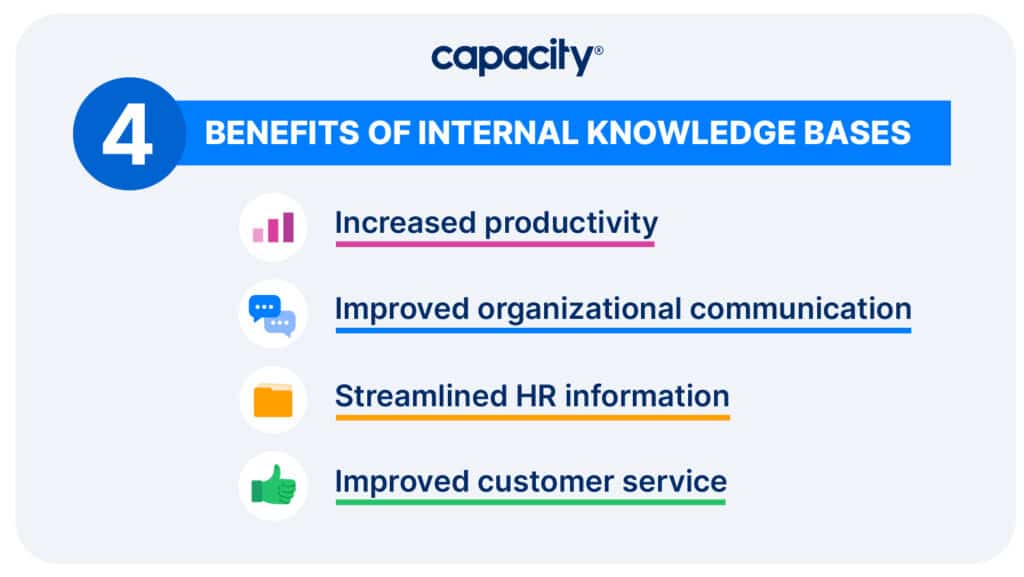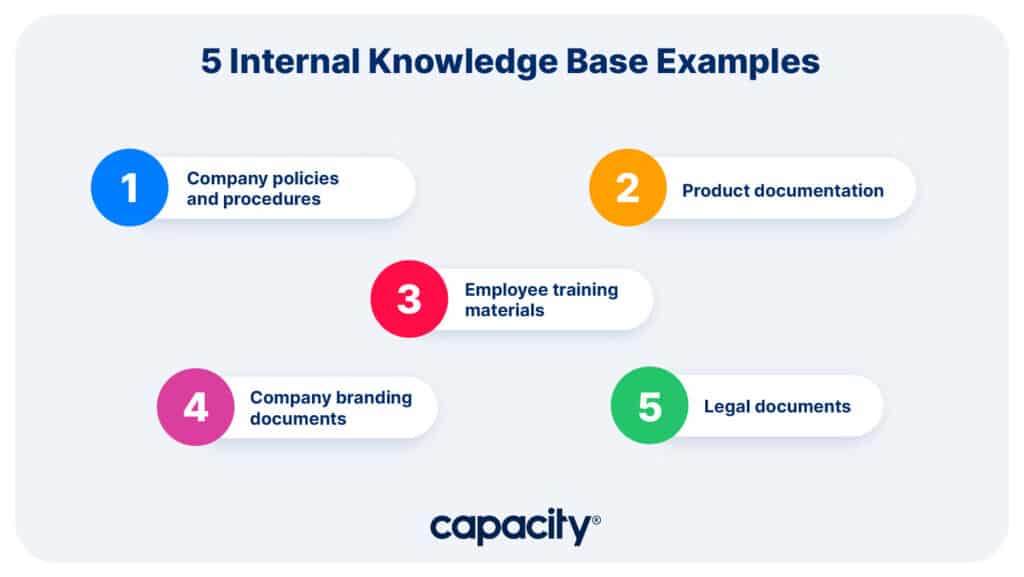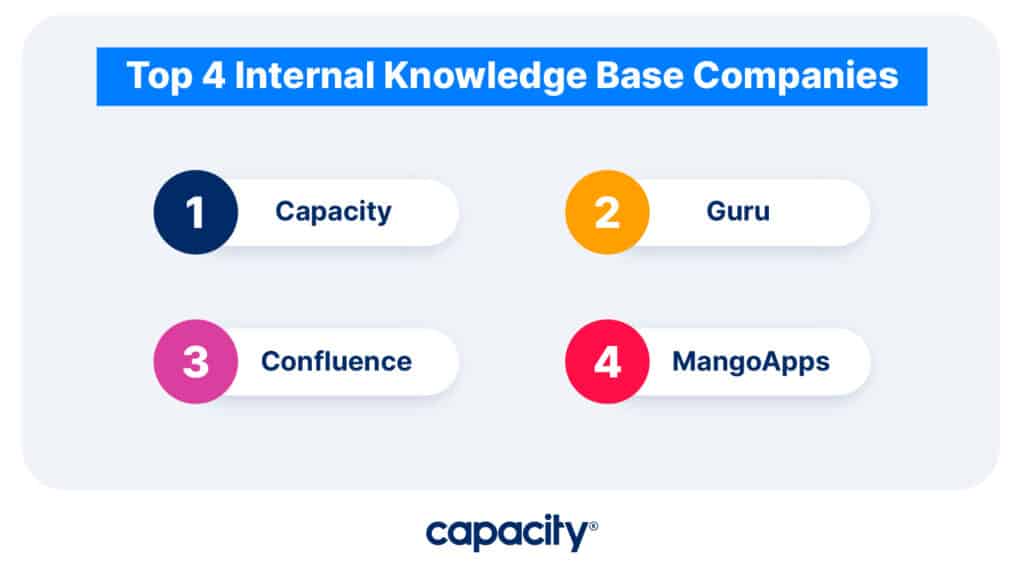Gone are the days of relying solely on internal documents and manuals to store employee knowledge – with internal knowledge bases, organizations can now easily create a powerful resource for their employees to access reliable information quickly. Building a knowledge base can be incredibly beneficial for businesses everywhere. It helps streamline processes by enabling team members to quickly access the information they need. It allows organizations to use their internal resources better and more closely monitor employee performance. With the help of AI technology, internal knowledge bases can become even more powerful, enabling businesses to have an up-to-date internal resource that is continuously learning and growing.
What is an internal knowledge base?
An internal knowledge base (KB) is a repository of confidential information crafted exclusively by an organization’s employees. Storing as much data and documentation in the knowledge base as possible gives employees a central place of truth to find crucial company information. Employee knowledge bases allow employees to work without interruption, making it easier for them to complete their jobs efficiently.

Intranet vs knowledge base: What’s the difference
An intranet is a private internal network of computers and other resources within an organization. It provides a secure platform for internal communication and collaboration between employees and allows access to internal databases and shared resources.
An AI-powered knowledge base, on the other hand, provides a more comprehensive system that stores employee data, processes it with artificial intelligence (AI) algorithms, and presents it in a way that is easy to access and understand. AI-driven internal knowledge bases allow for more efficient searching and faster information retrieval than traditional intranet systems. Users can also use internal knowledge bases to share technical information with employees quickly and securely, improving employee satisfaction and productivity.
4 benefits of internal knowledge bases

Organizations have seen their workflows significantly evolve with the shift to a remote workforce and the increasing digitization of assets. Using an employee knowledge base has become vital for companies looking to stay competitive. Here are just some of the advantages your business can gain from having one:
1. Decrease shoulder taps to increase productivity
A system to quickly and effectively share information within a company is essential for team productivity. According to Nintex’s research on America’s broken processes, an alarming 67% of employees surveyed stated that their company’s flawed workflows hinder them from achieving their best work results.
By creating a centralized source for employee collaboration and document sharing, teams can quickly access the information they need to complete their tasks. This helps to reduce search time and avoid unnecessary repetition of work. Furthermore, with internal knowledge bases, employees are less likely to rely on outdated resources or make mistakes, increasing productivity. As a result, organizations can improve their internal processes and maximize the efficiency of their workforce.
2. Improved organizational communication
Internal knowledge bases provide an excellent platform for teams to communicate effectively. By having all company information stored in one accessible place, employees can quickly find answers to questions they have or collaborate with their colleagues on projects. This makes it easier for teams to stay connected and share information without spending time looking for relevant documents or emails.
3. Streamlined human resource information
If you’re in the world of HR, you probably get asked these questions multiple times a day:
- How can I access my benefit summary?
- Where is my W-2 form?
- How do I request PTO?
- What does *insert company acronym here* mean?
Using an employee knowledge base presents many advantages. From benefits and compensation to organizational structures, legal documents, and company branding– users can safely store all in one place for quick access by HR specialists and employees — no need to wait for an answer or respond to the same question 5x times a day.
4. Improved customer service
Having internal knowledge bases also helps managers and customer service teams manage incoming requests with better accuracy and speed. Rather than searching for the correct documents or resources, internal KBs provide a way for customer service teams to quickly access the information they need to respond to customers’ inquiries. This can help reduce response times and improve customer satisfaction.
How to create an internal knowledge base
Creating a knowledge base is a great way to streamline processes and increase employee productivity. To get started, you’ll need to identify the key pieces of information that need to be stored in your internal KB. This could include internal documentation such as policies, procedures, and manuals; product information; customer service scripts; legal documents; team resources and more. The possibilities are endless! Look where your team needs the most help and ensure it aligns with your goals.
Once you have identified the information to be stored, you will need to select a platform for your internal knowledge base. Many platforms available can easily keep and organize documents and provide tools for employees to search, access, and edit content. Scroll to the bottom of this page to learn more!
Finally, you’ll want to ensure that your knowledge base is easily accessible to all employees. You can do this by setting up internal knowledge base roles and permissions and creating a simple tutorial or guide for employees on how to use it. With the right internal knowledge base system, your organization can quickly access the information they need and decrease shoulder taps.

5 internal knowledge base examples
Employee knowledge bases are a precious asset for any organization. Here are a few use-case examples to consider:
Company policies and procedures: This internal knowledge base example is essential for any business looking to provide employees with the information they need to stay compliant at all times. Examples include internal documents such as safety protocols, non-discrimination policies, code of conduct guidelines, and more.
Product documentation: If your organization produces products or services, you’ll want to create an internal knowledge base for product documentation. This could include product manuals, feature lists, usage instructions, or troubleshooting guides.
Employee training materials: Training materials such as videos, slideshows, and workbooks can be stored in internal knowledge bases to be used by employees at any time. It’s instrumental when onboarding new employees or providing refresher training for existing ones.
Company branding documents: If you want to maintain a unified brand message, internal knowledge bases are a great place to store all your logos, graphics, and other branding materials in one secure location. This will ensure that all internal and external materials are consistent in language and visuals.
Legal documents: Finally, employees can also use internal knowledge bases to store legal documents such as contracts, employee handbooks, confidentiality agreements, and more. Employees can quickly access the necessary documents without searching for them.

Top 4 best internal knowledge base software companies
1. Capacity
Capacity is an internal knowledge base software company that allows businesses to organize their information, store documents securely, and collaborate across teams. They offer features such as AI-powered search capabilities and app integrations with popular applications like Slack and G Suite.
2. Guru
Guru is an internal knowledge base software that provides organizations with a centralized source to store, share and access internal information. They have limited integrations with other work applications and needs the ability to publish internal content externally.
3. Confluence
Confluence is an internal knowledge management software created by Atlassian that helps teams organize information into one unified source. They have limited customization options for internal workflow processes and a steep learning curve for new users.
4. MangoApps
MangoApps is an internal knowledge base software that allows teams to easily create, store, and share internal documents and resources from one centralized hub. They have limited integrations with other apps and no mobile application.
Looking for free internal knowledge base software? Meet Capacity
Capacity is the ultimate internal knowledge base software. Businesses can easily store documents securely, organize information, and collaborate across teams. Its AI-powered search capabilities and intuitive app integrations, Capacity helps you easily find internal resources quickly and effortlessly. Plus, with its advanced security features, businesses can have peace of mind knowing their internal data remains safe and secure. Don’t settle for anything less than Capacity – the leading internal knowledge base software!
Capacity is genuinely a game-changer in internal knowledge base software, providing businesses with all the tools they need to store documents securely, organize information and collaborate across teams. Plus – you can try it for free today!





